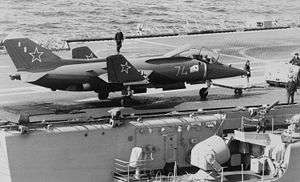SRVL
Shipborne rolling vertical landing (SRVL) is a method used to land a V/STOL aircraft that uses both the vertical thrust from the jet engine and lift from the wings.
A V/STOL aircraft normally either lands vertically or it makes a conventional runway landing. For a vertical landing it uses downward thrust from the lift fan and/or rotated jet nozzle(s), while for a runway landing the jet nozzle(s) are pointed rearward. With a rolling vertical landing the aircraft uses downward jet thrust to hover while it is still moving fast enough to also generate wing lift. This allows for a rolling landing with a significantly reduced approach speed and landing distance.
With an SRVL manoeuvre, a V/STOL aircraft can make a rolling landing on an aircraft carrier and come to an effective stop with the disc brakes in the landing gear. Unlike a conventional rolling landing on a carrier, this does not require the use of an arrestor wire and tailhook. The operational advantage of this technique is that it can increase the landing payload capacity of a V/STOL aircraft, which can be restricted when it lands vertically. It can also reduce the level of wear on the lift engines and extend their operational life. Similarly, it can reduce the amount of wear upon the deck surface of a carrier caused by the downward jet exhaust from vertical landings.
History


Harrier
An SRVL development program was undertaken with the Harrier by the UK defence manufacturer, Qinetiq.[1] In 2007 the company used their Vectored-thrust Aircraft Advanced Control (VAAC) Harrier test aircraft to demonstrate the feasibility of the landing technique on the French navy carrier Charles de Gaulle. A series of landing approach trials were also flown with the Royal Navy carrier HMS Illustrious in 2008. The carrier was fitted with a visual landing aid called a “Bedford Array”, which provides glidepath information to the pilot through a helmet-mounted display.
Yak-38
The Yak-38 "Forger" became operational with the Soviet Navy in the early 1970s. The aircraft was initially flown from carriers using VTOL only, but in the early 1980s trials were made with rolling landings on the Kiev class aircraft carriers.[2] The Yak-38 had a separate pair of lift engines with a very high fuel consumption, which reduced the range when it was flown with vertical take offs and landings. SRVL landings gave an improved range performance and were conducted with the use of a safety net. The aircraft was withdrawn from service in the 1990s.
F-35B
SRVL landing is under development for use with the F-35B when it enters service with the Royal Navy in 2018.[3] The aircraft will operate in the STOVL mode on the new Queen Elizabeth class aircraft carriers. Rolling landings will enable the F-35B to land on these carriers with an increased weapon and fuel load and will use the aircraft's computer controlled disc brakes. A number of defence analysts have suggested that operational SRVL landings may only be possible within a limited range of sea states.[4]
V-22
In October 2015, NAVAIR tested rolling landings and takeoffs with the Bell Boeing V-22 Osprey tiltrotor on a carrier, preparing for Carrier onboard delivery.[5]
References
- ↑ "Qinetiq-led team demonstrates carrier landing system for JSF". flightglobal.com. Retrieved 10 June 2012.
- ↑ "f-35 stovl has soviet roots yak 38 a". www.defence.pk. Retrieved 10 June 2012.
- ↑ "Lockheed gets funds for UK F-35 landing modification". flightglobal.com. Retrieved 10 June 2012.
- ↑ "F-35B STOVL - Too much Cash for too Little". sharkeysworld.com. Retrieved 11 April 2013.
- ↑ Tony Osborne (12 November 2015). "V-22 Osprey Testing Could Lead To Higher Takeoff Weights". Aviation Week.